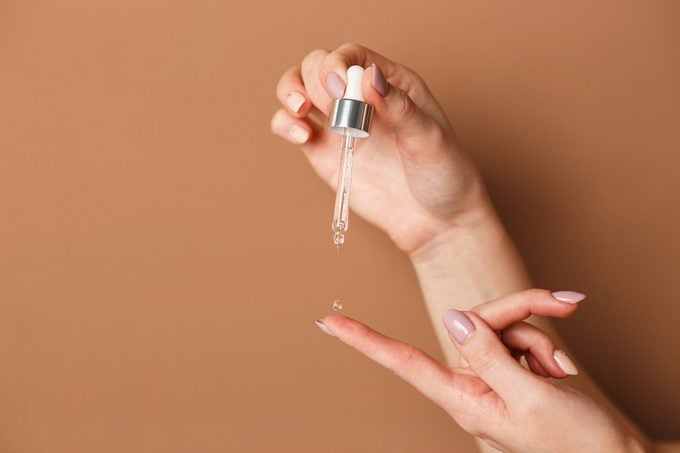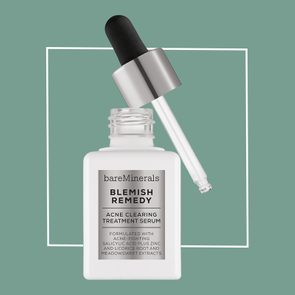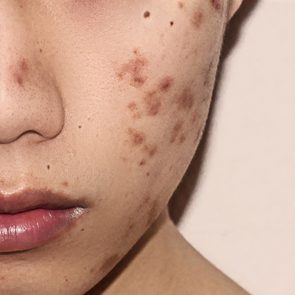Niacinamide and Your Skin: Benefits—Plus Expert Tips on Using It
Updated: May 20, 2021
Here's what to know about the benefits of niacinamide or niacinamide serum. Plus: How to use it in your skin care routine and why it pairs so well with other ingredients.
Our editors and experts handpick every product we feature. We may earn a commission from your purchases.
What is niacinamide?
Skin care lovers know all about the benefits of vitamin C, retinol, and sunscreen for the complexion. And now there’s another skin care ingredient in the dermatologist tool-kit: niacinamide.
This form of vitamin B3 (niacin) also goes by the name nicotinamide, and you can get it from foods like meat, poultry, and brown rice. But you’ll also reap rewards by slathering the vitamin onto your skin.
One reason dermatologists recommend niacinamide is that it benefits a wide range of skin conditions, says Annie Gonzalez, MD, a board-certified dermatologist at Riverchase Dermatology in Miami. It repairs skin barriers damaged by sunlight and pollution. “This works to decrease inflammation and irritation of the skin,” she says.
But that’s just one benefit. There are a host of others that make niacinamide an all-star add-on to your skin care regimen. Here’s what dermatologists want you to know about the trendy ingredient.
(Here are the best vitamins for acne.)
Niacinamide benefits
Niacinamide helps the skin naturally produce more ceramides, or fat molecules, which helps keep the skin moist and plump, says Dr. Gonzalez. Since the skin becomes drier and less plump as we get older, niacinamide can be a boon to aging skin. (This is how your skin ages through every decade of your life.)
The ingredient can also:
- Tighten pores
- Smooth lines or wrinkles
- Brighten pigmentation
- Fight acne
- Support the skin barrier
- Reduce inflammation
- Improve texture and tone
“Niacinamide helps create NAD+, which can help fight free radicals and repair skin damage,” says board-certified dermatologist Zain Husain, MD, founder of NJ Dermatology and Aesthetics Center.
Anti-aging
For a small study in the International Journal of Cosmetic Science, researchers asked 50 white women between the ages of 40 and 60 to use a 5 percent niacinamide moisturizer on half of their face. They applied it twice a day, using a placebo moisturizer on the other half. (This is what’s known as a “split-face” study.)
After eight weeks, researchers observed a reduction in the appearance of fine lines and wrinkles on the side of the women’s faces that used niacinamide compared with the other side. It reduced the yellowing of the skin, too. (Here are other great anti-aging skin care products.)
Hyperpigmentation
Research in the British Journal of Dermatology found that applying a 5 percent niacinamide moisturizer twice a day for four weeks improved hyperpigmentation. It lightened the skin compared with a regular moisturizer in a small trial involving Japanese women.
In another split-face study, this one published in 2011 in Dermatology Research and Practice, researchers asked 27 women with melasma (darker pigmentation) to test two ingredients for lightening the skin. For eight weeks, participants used 4 percent niacinamide on one side of their faces and 4 percent hydroquinone on the other.
Topical niacinamide wasn’t quite as effective as hydroquinone, but it did pretty well. For comparison, 44 percent saw a good to excellent improvement in their melasma with niacinamide versus 55 percent who saw the same with hydroquinone. On the plus side, only 18 percent of users experienced side effects with niacinamide, compared with 29 percent who had hydroquinone side effects like burning.
While it may not be the gold standard skin-lightening treatment, niacinamide is still a promising option, especially for people with dark spots who want to limit unwanted side effects that may come with hydroquinone. (These are the best sleeping facial masks for brighter skin.)
Acne
Niacinamide may be a good acne-fighting ingredient because it may reduce the production or excretion of sebum, an oily, waxy substance that may clog pores.
A study of 100 Japanese women and 50 white women, published in the Journal of Cosmetic and Laser Therapy, looked at a 2 percent niacinamide moisturizer on sebum excretion and production. Half of the women applied the niacinamide product, while the other used a placebo moisturizer for four weeks. Researchers found that sebum excretion was lower in Japanese women after two and four weeks of application. For the white women, only the sebum production reduced after six weeks.
Two other double-blind, randomized controlled trials back up the acne-fighting claims. Researchers publishing in the International Journal of Dermatology found that using a 4 percent niacinamide gel twice daily decreased moderate acne in eight weeks just well as 1 percent clindamycin (a standard topical antibiotic prescription for acne). And a study in the Journal of Research in Medical Sciences found that using a 5 percent niacinamide gel worked as well as a 2 percent clindamycin gel when it came to treating mild to moderate acne.
Moisturizing
This skin care ingredient may increase the production of ceramides in the skin, preventing water loss and helping skin hydration, per the British Journal of Dermatology. These ceramides could help repair the protective outer layer of skin and act as anti-inflammatory agents.

How to add niacinamide to your skin care routine
Opt for a niacinamide serum
When used properly, both niacinamide serums and creams will benefit the skin, according to Dr. Gonzalez.
“However, niacinamide can penetrate further into the pores and is more easily absorbed into the skin when it is applied as a water-soluble serum,” she says. “Serums are also more easily mixed with other products than creams, which allows for more ingredients to be included in a skin care regimen.”
Most niacinamide products have 2 to 10 percent niacinamide, according to board-certified dermatologist Morgan Rabach, MD, of LMMedical in New York City. She recommends starting with a 5 percent formula (such as this one from InstaNatural.) If your skin tolerates it, you can advance to a higher-concentration formula, like The Ordinary‘s 10 percent niacinamide serum.
People with sensitive skin should always start with a lower concentration. (These are the best serums for your summer skin problems.)
Make sure the product is water-based
Although Dr. Gonzalez prefers niacinamide serums, Dr. Rabach says it doesn’t matter if it’s in cream or serum form. It’s a personal preference, and your choice may depend on what other products you are using at the time.
What does matter, however, is that the product is water-based. This ensures it’s not based in oil, which isn’t good for acne-prone skin types.
Use it twice a day
Niacinamide is an ingredient that is gentle enough to be used twice a day, seven days a week, Dr. Gonzalez and Dr. Rabach say. To apply niacinamide, first wash your face and, if you use one, apply a toner. Add niacinamide next, before any moisturizers or skin oils.
“Niacinamide is an active ingredient, and you want to put active ingredients on the skin first and then moisturizer to seal it all in,” Dr. Rabach says. (Avoid these face-washing mistakes.)
Pair niacinamide with other topicals
One of the great things about niacinamide is that it’s a very stable molecule, according to Dr. Rabach. “It’s non-irritating and has a neutral pH,” she says. “It doesn’t interact with other active ingredients.”
In short: It plays well with others, including retinol. (There are the skin care ingredients you shouldn’t mix.)
Niacinamide and vitamin C
If your goal is to brighten the skin, look no further than niacinamide and vitamin C. Both are powerful antioxidants that work to repair skin cell damage, Dr. Rabach says.
“Niacinamide can help reduce hyperpigmentation by protecting the skin from free radicals,” Dr. Gonzalez says. “Vitamin C actually reduces any dark marks on the skin by blocking the melanin pigment.”
Still, there is some debate in the skin care world about applying niacinamide and vitamin C simultaneously. Some claim that mixing them together makes vitamin C less potent and could cause facial flushing or redness. Dr. Rabach and Dr. Husain advise against mixing them together or using at the same time.
Instead, use vitamin C in the morning and niacinamide at night. Or simply space out the application: Apply vitamin C serum, wait 10 minutes, then apply niacinamide serum.
Note that sometimes vitamin C can cause itchiness and redness of the skin. Niacinamide can help balance these side effects by decreasing inflammation and keeping the skin barrier healthy and hydrated. This is just another perk of using both niacinamide and vitamin C in your skin care routine.
Niacinamide and retinol
Niacinamide and retinol are a great combination because niacinamide balances the dryness and irritation that retinol causes. (Dr. Rabach says to apply niacinamide after your retinol.)
“When used frequently, retinol can cause the skin to become red, itchy, and even to burn,” Dr. Gonzalez says. “Niacinamide helps the skin produce ceramides, which retain moisture in the skin and act as anti-inflammatory agents.” (Here are some of the skin care products our editors love.)
In a 2016 study in the Journal of Drugs in Dermatology, researchers had 25 people with mild to moderate hyperpigmentation and other signs of aging, such as fine lines and wrinkles, use a cream containing 0.5 percent retinol, 4 percent niacinamide, resveratrol, and hexylresorcinol (a skin brightener) every night for 10 weeks. They all also used the same cleanser, hydrating serum, moisturizer, and SPF 30 sunscreen every day.
Fine lines improved as early as week two, and by week four, hyperpigmentation and overall skin tone improved, too. Although mild redness and flaking occurred at first, by week 10, people reported no stinging, itching, dryness, or tingling.
What results can you expect from niacinamide?
How long niacinamide takes to work can vary per person. The strength of niacinamide you use, the other items in your regimen, and the issues you hope to treat with niacinamide all play a role in how fast you’ll see improvement.
Dr. Rabach says it may take one to two months to see results. In general, the research found it may take anywhere from four to 12 weeks to see the benefits of niacinamide in the skin. (Here’s how to do age spot removal at home.)
Risks and side effects of topical niacinamide
The good news about niacinamide continues: Usually, it’s a very safe ingredient for people with all types of skin conditions. Dr. Husain says it’s especially beneficial for people with acne and rosacea. That said, there are rare cases where high niacinamide concentrations cause the skin to become red and irritated, says Dr. Gonazlez. People with sensitive skin should always use caution.
To avoid irritation, it’s best to try a “patch test” of niacinamide before applying it all over the face. Apply a small amount to the inside of the arm or wrist. If there is no redness or negative symptoms after a few days, then it’s likely your skin will react well to its use, Dr. Gonzalez says.
Remember that every person’s skin reacts differently to ingredients. Pay attention to how your skin reacts to the use of niacinamide. If any symptoms are painful or do not resolve on their own within the next day, make an appointment with a dermatologist for a customized treatment plan. If you see a dermatologist regularly, mention any niacinamide products before adding one to your routine.
The bottom line
There are lots of reasons to consider adding a water-based niacinamide serum or cream to your skin care routine. It’s an excellent ingredient for people with sensitive skin, and works well with ingredients like vitamin C and retinol. Always patch test products before use and run new products by your dermatologist, if you can.
Next, check out the best anti-aging products at every price point.


















